Jun 17, 2022
CRC/TRR 280 at the fib-Congress 2022 in Oslo
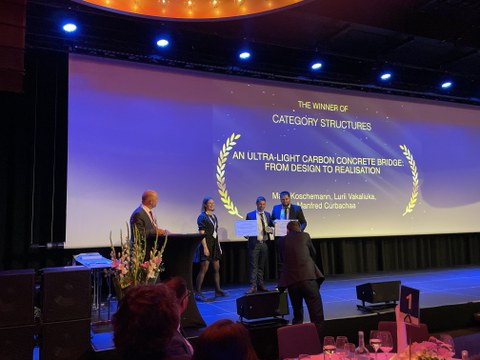
Marc Koschemann and Iurii Vakaliuk (Institute of Concrete Structures, TU Dresden) accept the award in the Structures category for their conference contribution on the topic of "Ultra-light carbon concrete bridge".
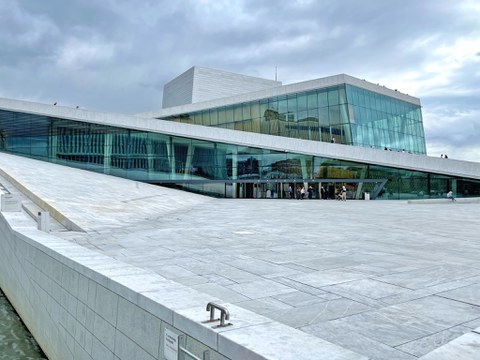
At the conference venue in Oslo, Norway
The Collaborative Research Center/Transregio 280 was strongly represented at the fib-Congress 2022 in Oslo, Norway, from June 12 to 16, 2022. The annual fib congresses have the highest relevance in concrete research; but also and especially for the scientists from the other disciplines of the CRC/TRR280 this congress was extremely important, as they gained an in-depth insight into various aspects around the construction with concrete.
Extrusion, 3D printing, vacuum concreting, sustainability assessment, chemical prestressing, botanically inspired reinforcement textiles - there were many interested queries and lively discussions on our diverse topics presented by CRC/TRR280.
If such a conference is already inspiring and profitable, the best came at the end: In the course of the competition for the Innovation Awards, conference contributions were honored that demonstrate the potential of concrete for future-oriented and sustainable construction. Of the five prizes awarded, two went to contributions directly from CRC/TRR280 (categories "Production" and "Durability") and one to a contribution from the research environment of CRC/TRR280 (category "Structures").
Category Durability:
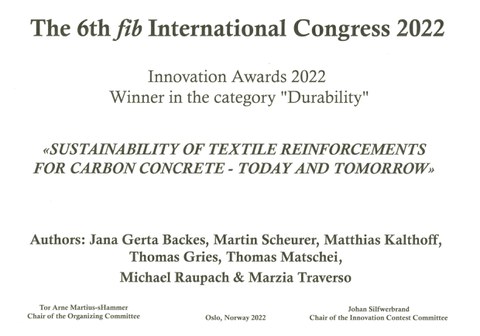
Award in the Durability category
SUSTAINABILITY OF TEXTILE REINFORCEMENTS FOR CARBON CONCRETE - TODAY AND TOMORROW by Jana Gerta Backes, Martin Scheurer, Matthias Kalthoff, Thomas Gries, Thomas Matschei, Michael Raupach and Marzia Traverso.
In the paper, the environmental performance of textile-reinforced concrete is evaluated in comparison with steel-reinforced concrete using the example of a double wall by applying Life Cycle Assessment (LCA) (ISO 14040/44).
Production category:
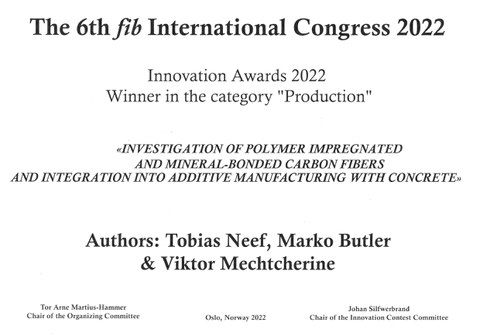
Award in the Production category
INTEGRATING MINERAL-BONDED CARBON FIBERS INTO 3D CONCRETE PRINTING by Tobias Neef, Marko Butler, Viktor Mechtcherine.
The construction industry is in a process of rethinking: away from "higher, faster, further" (and cheaper), towards a sustainable, durable, environmentally friendly and highly digitalized and automated construction industry. Additive manufacturing with concrete, also called 3D concrete printing (3DCP), has evolved from these requirements. It enables formwork-free, robotic construction. Lean construction assists in more efficient use of valuable resources. However, the integration of reinforcement into 3D concrete printing remains a major challenge. This paper presents recent work at TU Dresden on the integration of mineral and polymer-bonded carbon fiber heavy tow into additive manufacturing with concrete.
Structures category:
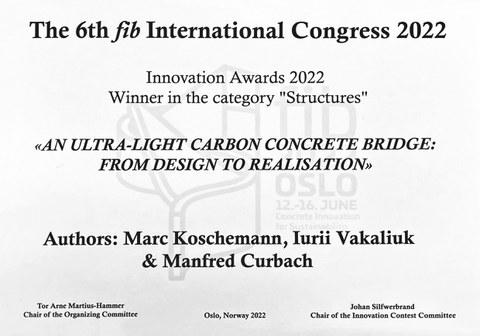
Award in the Structures category
AN ULTRA-LIGHT CARBON CONCRETE BRIDGE: FROM DESIGN TO REALIZATION by Marc Koschemann, Iurii Vakaliuk, Manfred Curbach
The demand on the building of the future is to conserve resources and save CO2. The use of innovative building materials and their combination as well as the optimization of structures with regard to the flow of forces are essential components to achieve this goal. The potential of hybrid concrete construction is demonstrated by an exhibition bridge made of carbon reinforced concrete and infralight concrete.
The CarboLight bridge is part of the modernization of the Deutsches Museum in Munich towards forward-looking innovations. With a length of 9.5 m, the bridge is designed as a filigree structure consisting of two slightly inclined V-columns, a three-part superstructure and a construction weight of only 2.1 t.
Congratulations to all award-winning colleagues! We are pleased that the work in our Collaborative Research Center/Transregio 280 has received recognition and international appreciation.
The next fib Symposium will be held in Istanbul, Turkey, from June 5 to 7, 2023!
Further information: fib Symposium 2023
